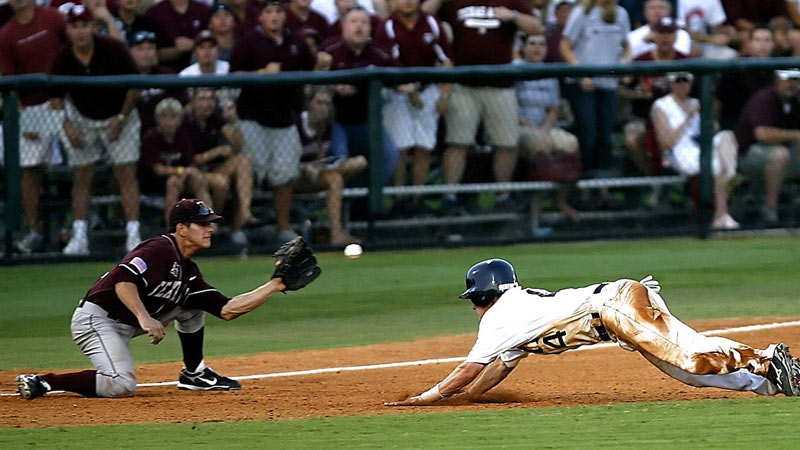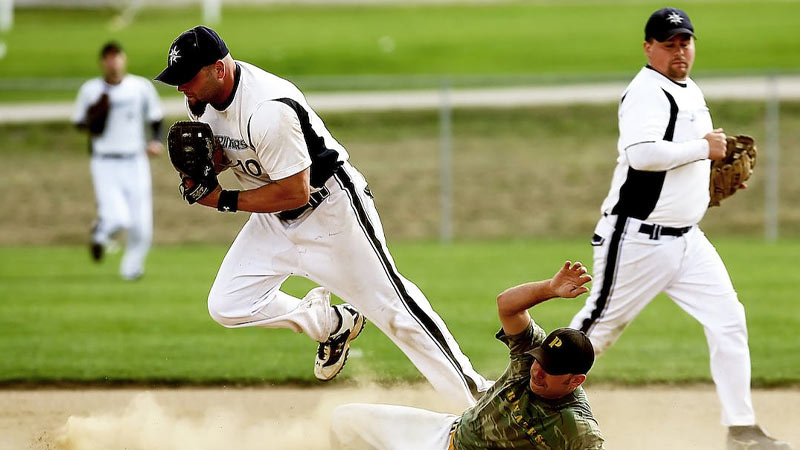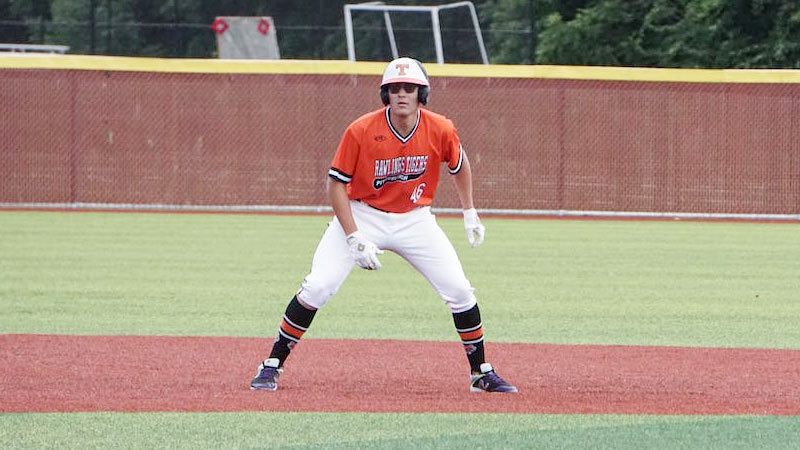Fielder’s Choice is a crucial yet often misunderstood concept in the game of baseball. When a batter hits a ground ball or a line drive, and the fielding team has the opportunity to record an out at a base other than first, a fielder’s choice is at play.
In this tactical maneuver, the fielder opts to retire a baserunner instead of the batter, usually because the baserunner is closer to home plate. This strategic decision can result in preserving a scoring opportunity, preventing a double play, or advancing the defense’s position.
This article aims to unravel the intricacies of fielder’s choice, examining its impact on the game and shedding light on the underlying strategies employed by both teams on the field.
Fielder’s Choice
In the game of baseball, a fielder’s choice refers to a situation where a fielder, who has the opportunity to make a play on a batted ball, chooses to make an out on a baserunner instead of attempting to get the batter out.
Essentially, it’s a decision made by the fielder to exchange one out for another. The fielder can choose to retire any runner on base, and if successful, the batter is not credited with a hit but is instead considered to have reached base on a fielder’s choice.
How It Differs From a Base Hit or an Error
A fielder’s choice is different from a base hit or an error because it doesn’t credit the batter with a hit or an error to the fielder. In a base hit, the batter successfully reaches base by hitting the ball and safely reaching first before the fielder can make a play.
An error, on the other hand, occurs when a fielder makes a misplay or fails to make a routine play, allowing the batter to reach base. In a fielder’s choice, the batter reaches base due to the fielder’s decision to make an out on another runner rather than the batter.
Situations Where a Fielder’s Choice Occurs
A fielder’s choice typically occurs in situations where there is a runner on base, and a batted ball is hit toward the fielder. The fielder has multiple options: either attempt to make an out at first base to get the batter out or try to throw out a baserunner advancing to another base.
If the fielder chooses to get the runner out instead of the batter, it results in a fielder’s choice.
Scenarios to Illustrate Fielder’s Choice
- Scenario 1: There is a runner on first base, and the batter hits a ground ball to the shortstop. The shortstop could throw to second base to try to get the lead runner out, but instead decides to throw to first base to get the batter out. The batter reaches base on a fielder’s choice.
- Scenario 2: With a runner on second base, the batter hits a line drive to the outfield. The outfielder catches the ball and decides to throw to third base to attempt to get the advancing runner out. In this case, the batter reaches base on a fielder’s choice.
These scenarios highlight how the fielder’s choice occurs when the fielder chooses to make an out on a baserunner instead of attempting to get the batter out, resulting in the batter reaching base on the fielder’s choice.
Scoring a Fielder’s Choice

When scoring a fielder’s choice, the official scorer records the play in the game’s scorecard or official record. The batter’s at-bat is recorded, and instead of marking it as a base hit or an error, it is noted as a fielder’s choice.
The specific details of the play, such as which fielder made the choice and the runner(s) involved, are also recorded. This scoring notation helps track the sequence of events during the game accurately.
Differences Between Earned and Unearned Runs
In baseball, runs can be categorized as earned or unearned, depending on whether they are attributed to the pitcher’s performance or defensive errors.
When a run scores on a fielder’s choice, whether it is considered earned or unearned depends on the official scorer’s judgment. If the scorer determines that the defensive play was routine and should have resulted in an out, any subsequent runs scored are considered earned.
However, if the scorer deems the defensive play to be an error, any runs resulting from the fielder’s choice would be considered unearned.
Impact on Pitcher’s Statistics
A fielder’s choice can affect a pitcher’s statistics, particularly in terms of earned run average (ERA). If a pitcher gives up a hit that is later scored as a fielder’s choice, the run(s) resulting from that play will count towards the pitcher’s earned run total.
However, if the run(s) are deemed unearned due to an error, they will not count toward the pitcher’s earned run total. This distinction is crucial for evaluating a pitcher’s performance and determining their effectiveness in preventing runs.
It’s important to note that a fielder’s choice does not directly impact the pitcher’s win-loss record. The win or loss is attributed to the pitcher’s team as a whole rather than the individual pitcher.
However, the fielder’s choice can indirectly contribute to the outcome of the game by affecting the number of runs scored and potentially influencing the final result.
Common Misconceptions and Clarifications
There are a few common misconceptions about the fielder’s choice in baseball that can lead to confusion. One misconception is that a fielder’s choice is always a deliberate decision made by the fielder.
In reality, a fielder’s choice can occur even if the fielder didn’t have a choice at all. It simply refers to a play where a fielder chooses to make an out at one base while allowing the batter-runner or another runner to advance to a different base.
Clarifying Situations Where a Fielder’s Choice is Applicable
A fielder’s choice typically arises in situations where there is a runner on base and a ground ball is hit. The fielder has the option to either try to make an out at one base or attempt a more challenging play to get the batter-runner out at the first base.
If the fielder chooses to make the out at another base, and the batter-runner reaches first base safely as a result, it is recorded as a fielder’s choice.
This play can happen on routine ground balls or even on line drives if the fielder opts to throw to another base instead of trying to turn a double play.
Potential Confusion
To illustrate potential confusion surrounding the fielder’s choice, consider the following scenarios:
- Scenario 1: With a runner on first base, the batter hits a ground ball to the shortstop. The shortstop throws to second base to force out the runner, while the batter reaches first base safely. In this situation, the play is scored as a fielder’s choice because the shortstop made a choice to get the out at second base instead of attempting to throw out the batter at first.
- Scenario 2: With a runner on third base, the batter hits a sharp line drive to the third baseman. The third baseman catches the line drive and quickly tags the runner on third base, who is off the base. The batter-runner safely reaches first base. This play is also recorded as a fielder’s choice because the third baseman had the choice to either tag the runner or throw to first base to attempt a double play.
By providing examples and clarifications, it becomes evident that the fielder’s choice is not always straightforward and can lead to confusion among fans and even players.
Strategic Considerations
Fielders and baserunners need to make strategic decisions when a fielder’s choice situation arises. Fielders must quickly assess the situation, including the speed of the baserunners, the batter’s running speed, and the potential for a double play.
They must decide whether to attempt a double play by throwing to a base other than first or to focus on getting the lead runner out. Baserunners, on the other hand, need to read the play and determine whether to advance to the next base or stay put to avoid getting caught in a rundown.
Advantages and Disadvantages of Choosing a Fielder’s Choice

Advantages
- Potential for double plays: By choosing a fielder’s choice, fielders can initiate a double play, which can quickly eliminate multiple baserunners and change the momentum of the game.
- Increased outs: Choosing a fielder’s choice ensures an out, which can be advantageous in situations where a team needs to prevent runs from scoring or minimize the opposing team’s offensive opportunities.
Disadvantages
- Missed opportunities for outs: Opting for a fielder’s choice instead of trying to throw out the batter-runner at first base may result in a missed opportunity for an out if the batter-runner reaches safely.
- Risk of errors: The more complex the play, such as attempting a double play, the higher the risk of errors, which could lead to additional baserunners or runs for the opposing team.
Managerial Perspectives on Using Fielder’s Choice as a Strategy
Managers play a crucial role in deciding when to utilize the fielder’s choice as a strategic option. They consider factors such as the game situation, the strength of their defensive players, and the skill of the opposing baserunners and batter.
Managers may choose to employ fielder’s choice to prevent a big inning, initiate a double play to end a rally or take advantage of a slow baserunner.
They must weigh the potential benefits and risks associated with the fielder’s choice and make informed decisions to give their team the best chance of success.
Fielder’s Choice in Game Situations
Here are some of the specific scenarios where the fielder’s choice plays a significant role.
- Runners on base: When there are baserunners and a ground ball is hit, the fielder has the option to throw to a base to get a force out instead of attempting to throw out the batter-runner at first. This decision is based on factors such as the speed of the runners, the number of outs, and the game score.
- Sacrifice bunt: In sacrifice bunt situations, the batter intentionally bunts the ball to advance the baserunners while sacrificing their own chance of reaching base safely. If a fielder chooses to get an out at a base instead of attempting to retire the batter, it results in a fielder’s choice.
- Slow-hit ground balls: When a ground ball is hit slowly, fielders may have to make a quick decision on whether to throw first for the out or attempt a force out at another base to prevent a faster runner from advancing. In such cases, a fielder’s choice can come into play.
Impact on Game Dynamics and Outcomes
Fielder’s choice can significantly impact the game dynamics and outcomes. The decision to go for a fielder’s choice can lead to various scenarios:
- Preventing runs: By choosing a fielder’s choice and initiating a force-out, fielders can prevent a run from scoring, particularly with a runner on third base. This defensive play can change the momentum of the game and keep the opposing team’s scoring opportunities in check.
- Turning double plays: Fielder’s choice often comes into play in double-play situations. If fielders successfully execute a fielder’s choice by getting the lead runner out and then throwing to another base for a force-out, they can quickly eliminate multiple baserunners and potentially end an inning without allowing any runs.
- Offensive opportunities: On the offensive side, a batter reaching base via a fielder’s choice can still contribute to advancing the game. For example, if a runner on first base gets out due to a fielder’s choice, the next batter has the opportunity to drive them in with a hit or a subsequent play.
Notable Fielder’s Choice Plays in Baseball History
Throughout baseball history, there have been several notable fielder choice plays that have had a significant impact on games and even championship series.
Some examples include:
- Bill Mazeroski’s walk-off home run (1960 World Series, Game 7): In one of the most memorable moments in baseball history, Mazeroski hit a walk-off home run in the bottom of the ninth inning to win the World Series for the Pittsburgh Pirates. The play began as a fielder’s choice attempt when a ground ball was fielded, but the throw to first base was late, allowing Mazeroski to come to the plate and hit the game-winning home run.
- Derek Jeter’s flip play (2001 ALDS, Game 3): In a critical postseason game between the New York Yankees and the Oakland Athletics, Derek Jeter made a remarkable fielder’s choice play. With a runner on first base, a ground ball was hit into the outfield, but the throw to the cutoff man was off target. Jeter, positioned near the first baseline, made a backhanded flip to catcher Jorge Posada, who tagged the runner out at home plate. This unconventional fielder’s choice play saved a run and helped the Yankees win the game.
Why is It Called a Fielder’s Choice?

The term “fielder’s choice” in baseball refers to a situation where the fielder has the option to choose which baserunner to put out. The name “fielder’s choice” comes from the fact that the fielder has the choice to make an out at one base while allowing the batter-runner to reach safely.
When a fielder has the ball and multiple baserunners are on base, they can decide to throw the ball to a base to force out a runner instead of trying to throw out the batter-runner at first base.
This decision is based on various factors such as the speed of the runners, the number of outs, and the game situation. By choosing to get out at a base other than first, the fielder is exercising their choice.
The term “fielder’s choice” emphasizes the strategic decision-making aspect of the play. It highlights that the fielder has the discretion to select the most advantageous play based on the circumstances, rather than being limited to a predetermined course of action.
A fielder’s choice is named as such because it represents the fielder’s ability to choose which baserunner to put out, providing them with a strategic decision-making role in the game.
How Do Scorebooks Record a Fielder’s Choice?
In scorekeeping, a fielder’s choice is recorded in the scorebook to accurately reflect the play and the outcome. When a fielder’s choice occurs, it is typically denoted with the abbreviation “FC” in the scorebook, followed by the appropriate base number where the out was made.
For example, if the fielder chooses to make an out at second base, it would be recorded as “FC 6” (shortstop), “FC 4” (second baseman), or “FC 5” (third baseman), depending on which fielder made the play.
The scorekeeper will also indicate the runner who was safe as a result of the fielder’s choice. This is done by placing a small dot or circle around the player’s batting order number to indicate that they reached the base safely.
The fielder’s choice is not counted as a hit for the batter since they were not able to reach base safely due to the fielder’s decision to make an out elsewhere.
By accurately recording the fielder’s choices in the scorebook, scorekeepers can capture the flow of the game and provide a detailed account of the defensive plays made by the fielders.
This information is valuable for tracking player performance, analyzing game situations, and determining the impact of the fielder’s choices on the overall outcome of the game.
Fielder’s Choice Plays in Baseball
| Scenario | Explanation |
| Runner on a first, ground ball to the shortstop | Shortstop throws to second base to force out the runner, who is safe at second while the batter is out at first. |
| Runner on the third, ground ball to the third baseman | The third baseman throws home to try to tag out the runner, but the runner reaches the plate safely while the batter is out at first. |
| Bases loaded, ground ball to the second baseman | The second baseman throws to home plate to force out the runner, preventing a run while the batter is out at first. |
| Runner on first, the line drive was caught by an outfielder | Outfielder throws to first base to try to double off the runner, but the runner reaches first safely while the batter is out. |
| The runner on the second, fly ball caught by the outfielder | Outfielder throws to third base to try to tag out the runner, who advances to third safely while the batter is out. |
| Runner on a first and second, ground ball to the first baseman | First baseman steps on first base for the force out, allowing the runners to advance to second and third safely while the batter is out. |
FAQs
Is a fielder’s choice considered an out?
Yes, a fielder’s choice is recorded as an out in the scorebook. It occurs when a fielder chooses to make a play on a baserunner instead of attempting to put out the batter-runner.
The batter is declared out, but the runner may advance or reach base safely.
Can a fielder’s choice result in a double play?
Yes, a fielder’s choice can result in a double play. If there are multiple runners on base and the fielder successfully forces out one runner while the batter is put out, they can quickly throw to another base to force out an additional runner, completing a double play.
Does a fielder’s choice affect a batter’s statistics?
A fielder’s choice does not count as an official at-bat for the batter, and therefore, it does not directly impact their batting average. However, it does count as a plate appearance.
The batter’s on-base percentage (OBP) may be affected if the runner(s) who advanced or reached base safely on the fielder’s choice eventually score.
Can a fielder’s choice be considered an error?
No, a fielder’s choice is not considered an error. An error is recorded when a fielder fails to make a routine play that could have resulted in an out.
In a fielder’s choice, the fielder successfully makes a play on a baserunner, resulting in an out, even though another runner may advance or reach base safely.
Is a fielder’s choice the same as a sacrifice bunt or sacrifice fly?
No, a fielder’s choice is different from a sacrifice bunt or sacrifice fly. In a fielder’s choice, the primary objective is to put out a baserunner, whereas in a sacrifice bunt or sacrifice fly, the objective is to advance a runner while willingly sacrificing an out.
Wrapping Up
The concept of a fielder’s choice adds an intriguing dimension to the game of baseball. It involves tactical decisions, strategic maneuvers, and the potential for game-changing outcomes.
Fielder’s choice plays can shape the dynamics of a game, impacting pitchers’ statistics, altering run-scoring opportunities, and showcasing remarkable defensive prowess.
Hopefully, you’ve understood the entire fact of the fielder’s choice. Still, if you have any confusion let, please inform us in the comment section. Thank you for your time.







